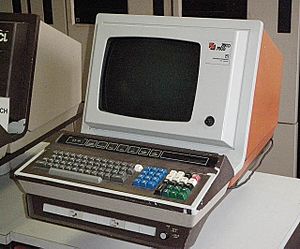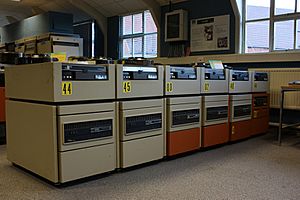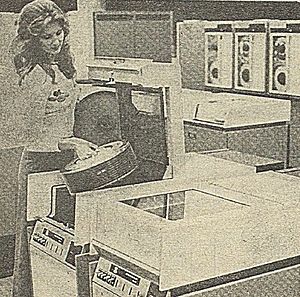ICL 2900 Series facts for kids
The ICL 2900 Series was a group of large, powerful computers called mainframes. A British company named ICL first announced them on October 9, 1974. ICL started working on these computers right after the company was formed in 1968. They wanted to create something completely new, not just an updated version of older machines. The goal was to combine the best ideas from different computer designs into one "synthetic option."
Later, in the mid-1980s, the 2900 Series was followed by the ICL Series 39. However, the Series 39 and other ICL computers that came after it still used the same basic design ideas as the 2900 Series.
Contents
How the ICL 2900 Series Began
When ICL was created in 1968, it was a merger of several computer companies. ICL had to decide what kind of computers to build next. They thought about improving their existing computers, but they chose a new path instead. This new path was called the Synthetic Option. It meant they would design a brand-new computer system from scratch.
Many different ideas influenced the design of the 2900 Series. Some ideas came from ICL's older machines. Computers made by the Burroughs Corporation also played a role, though ICL didn't want to design their computers just for one programming language. The Multics system gave them ideas about how to protect computer information. But the biggest influence came from the MU5 machine, which was developed at Manchester University.
How the ICL 2900 Series Worked
What is a Virtual Machine?
The 2900 Series computers used a special idea called a virtual machine. Think of a virtual machine as a private workspace for each computer program. Every program gets its own set of tools and resources, like its own memory space. This is a bit like how a process works in other computer systems.
In this private workspace, computer code can run at different security levels, up to sixteen of them. The most important parts of the computer's operating system, like the "kernel" (the core of the system), run in the same virtual machine as your programs. This means that when a program needs to ask the operating system for something, it's a quick change in security level, not a slow jump to a completely different virtual machine. This design helps keep the system safe and organized.
Parts of the computer's memory can be shared between these virtual machines. There are "public segments" for the operating system, which all programs can see. There are also "global segments" for programs to share data if they need to communicate with each other, like for database information.
The main part of the computer that does all the calculations, known as the central processing unit (CPU) in other systems, was called an "Order Code Processor" (OCP) in the ICL 2900 Series.
How Does the Computer Find Information?
The 2900 Series had a special way of organizing information using something called a call stack. This was very good for running programs written in high-level languages (like COBOL or FORTRAN), especially those that could call themselves repeatedly (recursive functions). The computer had special internal tools to manage this stack.
Data that wasn't on the stack was usually found using a "descriptor." This was like a detailed address label that told the computer where the data was, how big it was, and what kind of data it was (like text or numbers).
The way the computer understood instructions (its "order code") wasn't strictly fixed. This meant that the 2900 Series could pretend to be other types of computers. However, most 2900 Series machines used a common set of instructions called the PLI (Primitive Level Interface). This was designed to work well with programs written in high-level languages.
The computers had several special storage areas called "registers." For example, an "accumulator" (ACC) was used for general calculations. Other registers helped the computer find information in lists or manage the stack.
The 2900 Series could handle different types of numbers, including whole numbers, decimal numbers, and very large or small numbers (floating point). It also worked with text, usually using a code called EBCDIC.
Sometimes, the 2900 Series computers didn't seem as fast as competitors' machines if you just looked at how many instructions they could do per second. But because of their smart design, especially how they handled system requests, they often performed just as well in real-world tasks. ICL even used a term like "IBM equivalent MIPS" to compare their performance to IBM's computers.
Different Models of the ICL 2900 Series
| Processor | Model | Announced | Delivered | Later models |
|---|---|---|---|---|
| P-series | ||||
| P4 | 2980 | Oct 1974 | Jun 1975 | |
| P3 | 2970 | Oct 1974 | Dec 1974 | |
| P2L | 2960 | Mar 1976 | Dec 1975 | |
| P2S | 2950 | Cancelled | ||
| PI | 2940 | Cancelled | ||
| P0 | 2930 | Cancelled | ||
| S-series | ||||
| S4 | Cancelled | |||
| S3 | 2966 | Nov 1980 | Jun 1981 | 2955, 2958, 2977, 2988 |
| S2 | 2956 | Nov 1980 | - | |
| S1 | 2950 | Nov 1977 | Jun 1978 | 2946 |
The P (Parallel) Series: The First Models

The first computers in the 2900 Series were the 2980 and 2970. The 2980 was very powerful for its time. It could have one or two "Order Code Processors" (OCPs), each able to handle up to 3 million instructions per second. It could also have a lot of memory, up to 8 megabytes.
The 2980 was the strongest of ICL's new mainframes. It included many parts like controllers for memory, storage, and network connections. It typically used large disk drives, tape machines, printers, and card readers. It could run different operating systems like VME/B, VME/K, and EMAS. A typical 2980 setup cost around £2 million in 1977, which would be much more today!
Unlike the 2980, the 2970 and 2960 models used a special technique called "microcoding." This allowed them to act like older computers, such as the 1900 Series.
These 2900 Series machines were built from many separate parts, each in its own cabinet. Other devices like printers or disk drives connected to the main computer using special cables and ports.
Starting up a 2960 Series computer was interesting. The main processor had a small control panel and a cassette player. When you turned it on, the computer would load its first instructions from a chosen device. Then, it would "GROPE" (General Reconnaissance Of Peripheral Equipment) around to find all the connected parts and figure out how the system was set up. This allowed it to load the rest of its operating system. Engineers could also use the cassette player to load special programs for checking the computer.
The S (Serial) Series: Newer, More Efficient Models
Later, ICL replaced the first machines with a new family based on the 2966 design. These were cheaper to build and used a simpler way of connecting parts, called "serial" connections, instead of "parallel" ones. The 2966 design was then made bigger and smaller to create a whole range of computers, from the very powerful 2988 down to the 2958. They even made versions with two processors.
More to Explore
- VME - The main operating system for the ICL 2900 Series.
- Edinburgh Multiple Access System - Another operating system used with the ICL 2900 series.
- Content Addressable File Store (CAFS) - A special way to store and find computer files.
- ICL Distributed Array Processor (DAP) - A unique type of computer processor.





